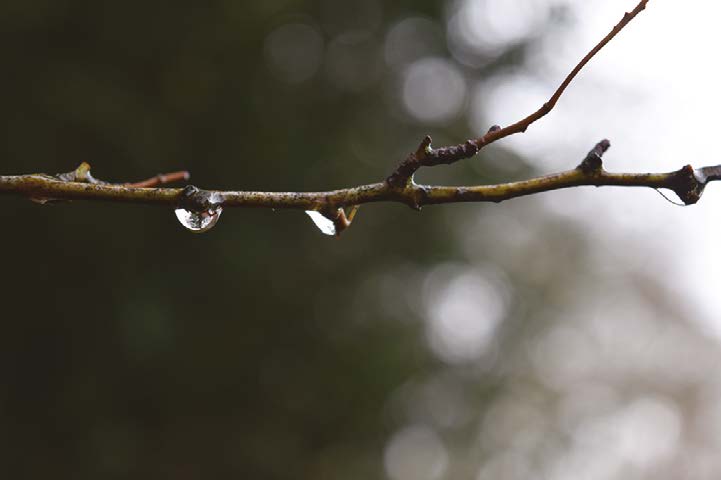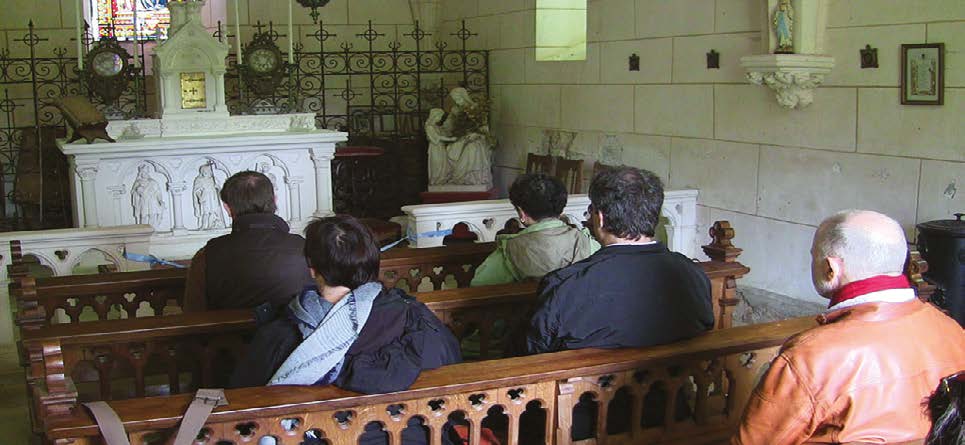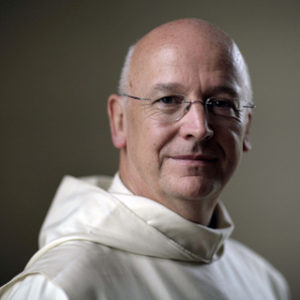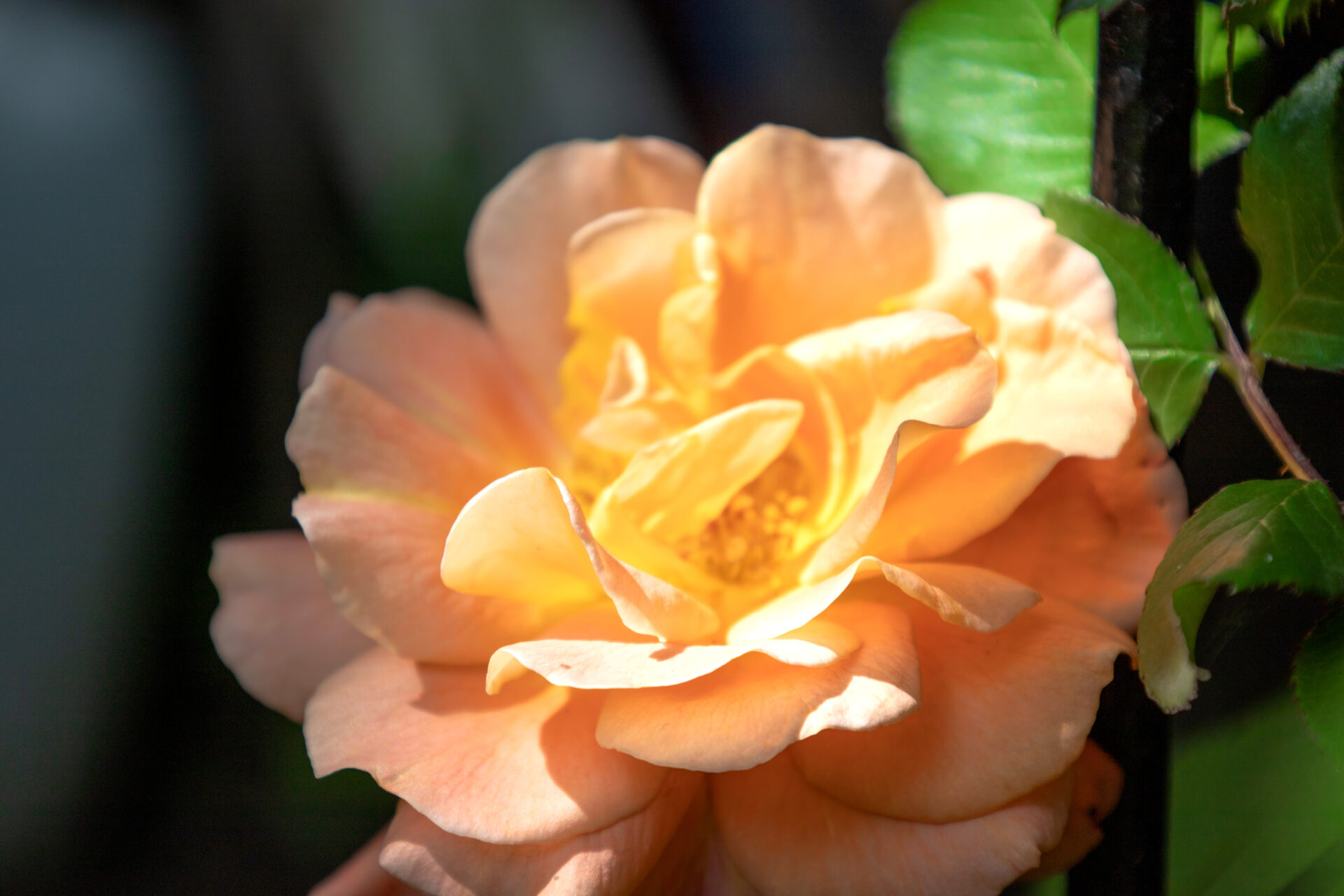I was shown around the emergency department of a busy hospital recently. It happened to be a quiet time but that, they told me, could change very quickly any day of the week. (Mondays and Fridays are usually the busiest). Even in a relatively calm period, the extremes of the human condition were visible: the thin lines of mortality that we constantly move through, happily busy one moment and stricken down the next, the always shaky wire we walk between well-being and pain; and, at the other extreme to the isolation and fear this creates in us, I could see the calmness that compassion needs to grow and to be bestowed, the generosity of spirit that reaches out to suffering without any self-interest or desire for personal advantage. In this season of the year it seemed to me to illustrate redemption in action, the healing of the human through the gift of one’s self.
Meditating with the doctors and nurses of this department over a number of weeks, I was able to reflect on some of the many meanings of health and of the dynamics of healing. I’d like to try to connect these meanings to some of the stories of our community that you will find in this issue of the Meditatio newsletter.
We often link the words ‘good’ and ‘health’. Both words, however, need to be handled with care. To be called good is gratifying. To be called bad creates shame (or denial). To be in good health doesn’t mean you are a good person. Being in bad health might well lead you to be a better person than you were before. The goodness lived out in the emergency department shone through a powerful and practical altruism. The self-isolating pain and fear in the patients were evident. But they were also touched by an almost painfully acute, healing awareness. It signified our ability to turn from our self towards others, as if this were always the easiest and most natural thing for anyone to do. This connection between pain and altruism (suffering and love) seemed to me to be the main channel of healing and the ambience of caring and attentiveness that pervaded the department. Extreme conditions –and there are few more extreme places than an A&E department – where the tensions of life are held in raw balance, can reveal deep mysteries in very simple ways.

Maybe this other-centredness also exists in the mega-deals of the financial world or in entertainment, or politics or in immigration officials screening refugees. But it is rarely as evident as in those men and women working in constant crisis management in the emergency department of a busy hospital. Their way of responding to a person admitted in desperate need instantly over-rides private tastes, prejudices and self-interest. It is quietly inspirational to behold – quietly, because they are not and do not want to be self-conscious of their being inspiring. Still, experienced emergency clinicians cannot but be awake to the deep level of satisfaction and meaning that their work gives them, even if they are reluctant to talk about it.
But they are no less aware of the risk involved in the work. Over months and years, such levels of continuous selfgiving can take more out of you than you realise. Skills learned over years of training once used with compassionate indifference may now become affected by a looming burnout which leads to a gradual internal shut-down. Automatic pilot takes over, more and more but the heart becomes separated. I saw a healthy awareness in them about this danger especially in those who are learning to meditate while living on shift work at this cutting edge of critical medicine, where the urgent demands of the human body constantly appeal for care and attention. Their desire to meditate was like anyone else’s. Their struggle to develop a good habit of meditating was essentially no different.
‘The world is a hospital endowed by the ruined millionaire.’ T.S. Eliot’s line, like the time I spent with these generous healers, awakened some of the mysteries of the Easter season. Life is the place of healing. We all need healing in different ways and different times, physically, emotionally or spiritually. There is no shame in that, although our need for healing is often felt to be a weakness that we should hide from others, as we hide our private parts while dressing up well. Being seen as ‘a picture of health’ is gratifying and on meeting someone we often flatter each other, ‘Nice to see you, You look so well’. Then, just in case, we add ‘How are you keeping?’ Deeper health and wholeness, however, are not states we can secure as we might build up a retirement fund. Deep health is neither a possession nor the result of chance. It is a gift that flows continuously, through the healing process. It is not held onto because it always prepares for the next stage of our journey.
The hospital of life equally welcomes both healthy and sick. The distinction between these two states of life is not as exclusive as it may seem. How do we know that the doctor who is treating your broken arm hasn’t just been diagnosed with a terminal illness? Or, perhaps the shock of that diagnosis will lead to a richer integration of the personality, reconciliation with the broken parts of oneself and an enhanced capacity to love others? The desert monks used the term apatheia to describe health of soul, when we flourish as a whole person, whether the body happens to be working well or not.
The symptoms of health and the symptoms of sickness are very different. Order, harmony , peace of mind, flexibility, spontaneity, attractive beauty (on the one hand) and chaos, violence, aggressivity, imbalance and natural revulsion (on the other). Yet, the worst can be transposed into the best. It begins with acceptance. This first step may be the hardest to take. The worst news naturally creates the temptation to deny what we don’t like. We see this demonstrated in political press conferences and interviews every day. They remind me of the time when as a young teenager I was smoking secretly, against my mother’s orders. One night in my room, feeling safe to rebel, I lit up and then heard steps coming upstairs. I quickly extinguished the cigarette but could not hide the clouds of evidence swirling around the room. When she entered, my mother confronted me and to her anger and maybe amusement and to my selfhumiliation at being so ridiculous, I denied it. Denial gets stronger the longer it is practiced. Ultimately it can become self-convincing and we end by believing the fake news we are producing. The first step is to be honest with ourself and others.
“Learning to meditate becomes a deep healing of the shame of the past and a reintegration of the divided self.”
After acceptance comes adaptation. Later in this issue you will read of a meditator in Hong Kong who struggled with bureaucracy to bring meditation into prisons. The biggest resistance she faced was the institutional conviction that meditation would not work for prisoners. It was too ‘advanced’ for them. She persevered and eventually succeeded. Being incarcerated and dehumanised can provoke huge denial and angry desperation but also, with time and help, acceptance leads to self-adjustment. Then, learning to meditate becomes a deep healing of the shame of the past and a reintegration of the divided self. After seeing yourself as a reject, you find a new self-respect in self-knowledge and wisdom. Because it thinks of prison as punishment and only formally as rehabilitation, the penal system rarely notices the kind of personal transformation that changes prisoners for good.
The better a healer knows the nature of the sickness the better she can heal. The story of the Passion that we read in Holy Week illustrates how Jesus was immersed in all the sicknesses of humanity that we can imagine, from physical pain to emotional rejection and an ontological dark night. Isaiah foretold this in his image of the suffering servant as a wounded healer:
And yet ours were the sufferings he bore, ours the sorrows he carried. But we, we thought of him as someone punished, struck by God, and brought low. Yet he was pierced through for our faults, crushed for our sins. On him lies a punishment that brings us peace, and through his wounds we are healed.
Is 43:4-5
Sickness and misfortune often awakens a sense of guilt or blame whether it is we or others who suffer. God, the ego believes, rewards the good and afflicts the bad. The ego is ever sensitive to its reputation. The fact of healing, however, exposes this fallacy. Wounds can heal, sickness can bring deeper health than we have ever known before, and being crushed can evolve into being raised up higher and healthier than we could have imagined. Even more, suffering can be redemptive.
In Greek mythology the first thing to exist, without any parental source, was Chaos. It was the void, the nothingness from which everything, even the gods, emerge. It is the underworld of darkness and mud. The word means gap or chasm because it is the space between heaven and earth. Myth needs to be understood psychologically. When sickness overwhelms us mentally or physically we descend into inner chaos. A chasm of separation opens between us as we were, and us as we are. We cannot relate to anyone or anything as we did before. We don’t like chaos and we are often ready to make false compromises, to deny the self-evident, to isolate ourselves from others to keep ourselves from falling into the abyss.
Denying suffering or loss, however, means denying our need for healing. At an increasing cost to our well-being and sanity, we keep up appearances, as if nothing has happened. My parents’ generation were resilient and self-reliant in ways their offspring might well envy; but they also often hid their feelings and refused to ask for help when they needed it most.
Their survival mechanisms were shaped by the most violent century of human history, but repression is itself a violence against oneself. Today repression is even easier. Virtual reality is at our fingertips. The click of a mouse, or swallowing a pill transports us into another world where we feel for a time that we are in control and that we choose whatever we like to make us feel better.
Technology often seems suspicious to the spiritually-minded. Science and the gadgets of technology are often employed in the service of the narcissistic ego. Eventually, however, the unreal undergoes an unavoidable death and the repression and self-delusion, the false appearances, collapse. I am quite tempted by gadgets; but I used to feel there was an opposition between technology and the divine which made it easier for people in a techno-culture to fall into chaos. Community, I believed, could only be experienced in person, with physical presence. The church says you can’t make a sacramental confession online. My experience of online meditation groups began to change this oversimplification. I first meditated online with a dying person, too sick to leave home, and I knew we were connected spiritually as well as digitally. Today with my fellow directors in the community we begin all meetings with meditation.
A real and holy connection exists between people who in any way meditate together. Perhaps this is because the spirit is not trapped inside the body like a ghost; the body is in the spirit. When Jesus appeared to his disciples who were immersed in the chaos of his death and thought they were seeing a ghost, he showed them he was at least as real to them as he was before. He is wholly physical, eating and touching with them. But only when the eye of their spirit is open, can they recognize him in this form. Meditating in an online group (a growing phenomenon described in this newsletter) is different from being in the same room. (You can, for example, mute the sound so that you can’t hear other people coughing.) But the presence is still real. The Spirit that unites flows among you; and koinonia, the communion of the good, is a felt reality.
The mosque in Victoria, Texas, burned down a few hours after the first order banning entry to the US from seven Muslim-majority countries. The local Jews immediately invited their Muslim neighbours, now bereft of a place of worship, to worship in their synagogue. The Jews said there were more Muslims than Jews in the town so they wanted to share the sacred space. The Muslims warmly accepted. They must have been healthy communities to begin with but the deep and inclusive koinonia they now shared made them healthier and happier.
Koinonia is the lived experience of community. The digital generation, nourished on the milk of technology from infancy, often uses it to create false intimacy in an alternative reality. But they long for koinonia. FaceBook friendships may offer some relief from the loneliness of the digital space they inhabit; but, like all false consolation, it lets them down and betrays their deeper selves.
Koinonia is the healthy experience of a community that has a strong enough identity to be hospitable to others and not define itself by what it excludes. The first task is to build that healthy community. Our Chinese meditators helped to do this recently by introducing meditation in the Catholic seminary in Beijing, where daily groups have now formed. Living and studying or working together, even worshipping together, is not enough to release koinonia. It needs collective interiority: honesty and a deep enough silence to meet in the place of truth with others. All relationships are subtly transformed by this silent truthfulness. Wonderfully, friendship is then seen to be the natural default of human relationship. Seeing this, the experience of even a very small community reaches beyond itself to touch the great, living network of relationships that, to our eye of faith, is the Body of Christ.
Recently a small group of meditators, who will help form the first residential community at Bonnevaux, visited our new WCCM home and international retreat centre. After the visit, we meditated in a little chapel next to the main house, which we hope to move into in the summer. The vision is strong, the world community is enthused – and the challenge to make it into a physical reality is very big. It will be realized through the combined dedication of resident and non-resident community members. After we meditated, I felt no essential difference between the local and the global community. In the Spirit, koinonia is one and the same.
Chaos is always threatening to overwhelm human existence, to suck hope out of us. The chasm of our mortality and the pains of loss and separation constantly destabilise the security we need in order to grow. Life is a busy hospital. We have to ensure that whoever we meet or work with, in this place of healing, finds a welcome. For St Benedict every guest must be made to feel as if he or she is Christ. In the community, those most in need, the sick, the young, the old and the stranger arriving at midnight are not regarded as burdens or expenses but reverenced.
This is how Chaos is turned into Cosmos. Through the power of koinonia, order and harmony transform chaos. Spirit once hovered over the formless face of the deep, devoid of light. It brought into existence the colourful variety of creation. So, too, our own spirit can face the chaos within ourselves and make of it a new creation. In this fresh world, we meet again those who have died and, as it at first seems to us, returned to chaos. Their form which we loved dissolved and they seemed to float away into the great forgetfulness. Koinonia, however, proves to be an unbreakable bond reaching beyond the chaos of separation. We know them no longer ‘after the manner of the flesh,’ as St Paul says of the risen Christ. But the enduring friendship which flows both ways grows more not less real with time. This is why we remember with love in this issue some of the members of our community who have recently died.
The chaos that medical caregivers might experience as burnout or a couple in turmoil as a marriage failure, is a reality to be reckoned with. Like corruption in the body politic, it should not be denied nor its power to wreak destruction underestimated. It can be confronted and healing can ensue through a hope born of koinonia. This is an emergency need of our digital and divided age. Through their faith in the risen Jesus, Christians understand that while we can build organisations with individual members and social networks; but we cannot form community merely as individuals. Perhaps in only one person at first, like John Main, there needs to be an interior dynamic of self-transcendence to begin the process of making communion incarnate as community. Cosmically, this one person is the risen Christ.
Chaos engenders fear. We feel it strongly in the political and social spheres today. But it can be defused and transformed into koinonia. Webs of healing, mutual support, teaching, inspiration and sheer celebration, the elaboration of projects of shared vision and the articulation of new ideas to connect rather than polarise: these are the tools and life-expression of community. Through them we both embrace our own need for healing and bring succour to others.
Never before have we needed so much to see community as a contemplative life emerging from the work of deep silence. True personal transformation must be the goal, not merely constructing a bolt hole from the surrounding chaos. Such a community will often appear weaker than it really is. It will be strong by being honestly vulnerable. Its fragility will be its flexibility and its power to adapt. In a chaotic world such local communities of cosmos are essential. They may not be great institutions or basilicas of power but they need to be places of rhythm and welcoming, silence and truthful dialogue. A contemplative community is not a protest group; but it is radical and it speaks truth to power.
In the poverty of silence, surrounded by the laughter and freedom of fearless people, a great, creative listening can happen. A community, sitting together, hearing each other cough or fidget, or meeting online, listens to a call that the media cannot hear. In restaurants and elevators, on customer service lines and in airports the fear of silence is reflected in the rising volume of muzak, advertising and trivial talk. They mask the symptoms of chaos but do not deal with the problem. Like all forms of distraction, one of the major causes of chaos today, they cover up rather than heal.
John Main said that ‘in meditation we are crossing over the threshold from background noise into silence’.

Silence is necessary for the human spirit to flourish. It may seem nonsense to many but there is no greater need in the modern world than for people, young and old, religious and secularized, rich and poor, to recover the experience of silence. This insight underpinned John Main’s dedication to teaching people how they can learn to meditate. We all need help and community; but we all have to learn to meditate in our own experience. Silence reconnects us to our own self-healing source. It restores truth to how we communicate and it builds a koinonia community that transcends the fear of death and chaos. ‘Meditation is the way to silence’. John Main’s had the genius of simplicity. It took form in his teaching on the mantra. It is more than a technique to calm the mind, though this is a welcome benefit of its discipline. Saying it changes us:
You become aware that you are on the threshold of silence. For many, this is a critical moment because you are leaving the familiar world of your sounds, ideas, thoughts and words. You are crossing over into silence; and you don’t know what’s in store for you. That’s why it is so useful to meditate in a group.. in a tradition that says, “don’t be afraid.” The purpose of meditation is to be in the presence of love, that, as Jesus tells us, casts out all fear.
Why be afraid of this silence, if it is there, here, within us? We only need to enter it to become the healing silence.
With much love,








